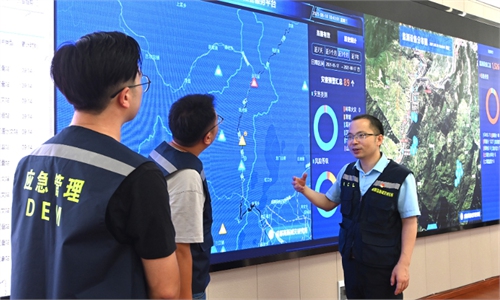Talim to become 1st typhoon to make landfall in China in 2023 as nation enters key anti-flood period

A man walks past a shopping mall with masking tape in the Tsuen Wan district as a precaution for the approaching typhoon Talim in Hong Kong on July 16, 2023. Talim, the fourth typhoon of 2023, is forecast to come ashore in China on the night of July 17, 2023. Photo: VCG
Talim, the fourth typhoon of 2023, is forecast to come ashore in China on Monday night, according to China's National Meteorological Center (NMC). If Talim makes landfall as forecast, it will be the first one to do so in China this year.
Talim, currently classified as a severe tropical storm, was located in the northeastern part of the South China Sea about 540 kilometers east-southeast of Zhanjiang, South China's Guangdong, at 4 pm Sunday, according to NMC. The center of the typhoon is expected to move northwestward at a speed of about 15 kilometers per hour and gradually increase in intensity.
Talim will likely be the first typhoon to make landfall or severely affect Guangdong this year, the National Marine Environmental Forecasting Center (NMEFC) warned.
According to the Ministry of Natural Resources, under the influence of Talim, coastal areas in South China's Hainan, Guangdong and Guangxi will experience strong waves. On Sunday afternoon, the NMEFC upgraded the wave warning to orange, while issuing a yellow warning for storm surges. The two alerts are the second and third levels, respectively, of China's four-tier extreme weather alert system.
Government departments in coastal cities and counties have been asked to call all vessels to return to ports to avoid the wind, maintain and reinforce aquaculture facilities and aquaculture fishing rafts, strengthen the inspection of coastal seawalls, locks and other facilities, and reinforce and de-risk the seawalls in weak and hazardous areas in a timely manner.
As of 10 am Saturday, 91 typhoon warning signals had been activated in cities and counties within Guangdong, the Nanfang Daily reported Saturday. According to weather forecasts, Guangdong will be hit by a severe storm from Monday to Tuesday.
As part of the precautionary measures, some trains in Guangdong will be suspended on Monday, the Nanfang Daily reported, including all trains traveling from Maoming to Guangzhou, Foshan and Shenzhen.
In addition, many scenic spots have issued suspensions, including at least four tourist attractions in the coastal city of Zhanjiang.
The number of typhoons that have been generated this year has been on the low side, and the first typhoon to make landfall will arrive late, Ma Jun, director of the Beijing-based Institute of Public and Environmental Affairs, told the Global Times on Sunday.
"It has made the pressure on China to prevent typhoon disasters relatively low so far."
Talim's landfall will come more than 20 days later than the average "first typhoon" landfall date, June 27, of the period from 1991 to 2020, according to NMC. As of Friday, there were 1.3 fewer typhoons generated this year than usual for this period.
However, some existing conditions could help Talim's development, including warm sea temperatures, improving overhead radiation conditions and the typhoon's smaller size, Nie Gaozhen, a senior engineer at the China Meteorological Administration, told the Nanfang Daily.
The first typhoon expected to make landfall in China comes as the country enters its annual critical flood control period, which runs from late July to early August.
China is forecast to experience both floods and droughts, with heavy rainstorms and flooding in certain areas, Wang Zhangli, a deputy director of the Water and Drought Disaster Defense Department of the Ministry of Water Resources, said on Saturday, the Xinhua News Agency reported.
Since entering the flood season in early July, no floods exceeding warning level have occurred on the main streams of the country's seven major rivers, but floods exceeding warning level have occurred on 255 rivers in 21 provincial-level regions, mostly small and medium-sized rivers, Wang said. Among them, eight small and medium-sized rivers experienced the largest floods since measured data became available.
A positive news, however, is that China's flood control capacity has improved significantly over the past few years, experts told the Global Times.
China's flood control capacity has been strengthened across the board in both "hardware" and "software," Ma told the Global Times. "For example, some cities have actively carried out the constructions of 'sponge cities' to deal with extreme heavy precipitation. Many coastal cities have enhanced the construction of sea defenses and dykes."
In addition, China's ability to forecast and warn about weather has also improved dramatically, Ma said.
"Enhanced computing power and improved models have enabled us to make earlier and more accurate forecasts, to make more accurate judgments, and also to communicate warning information faster and farther."



